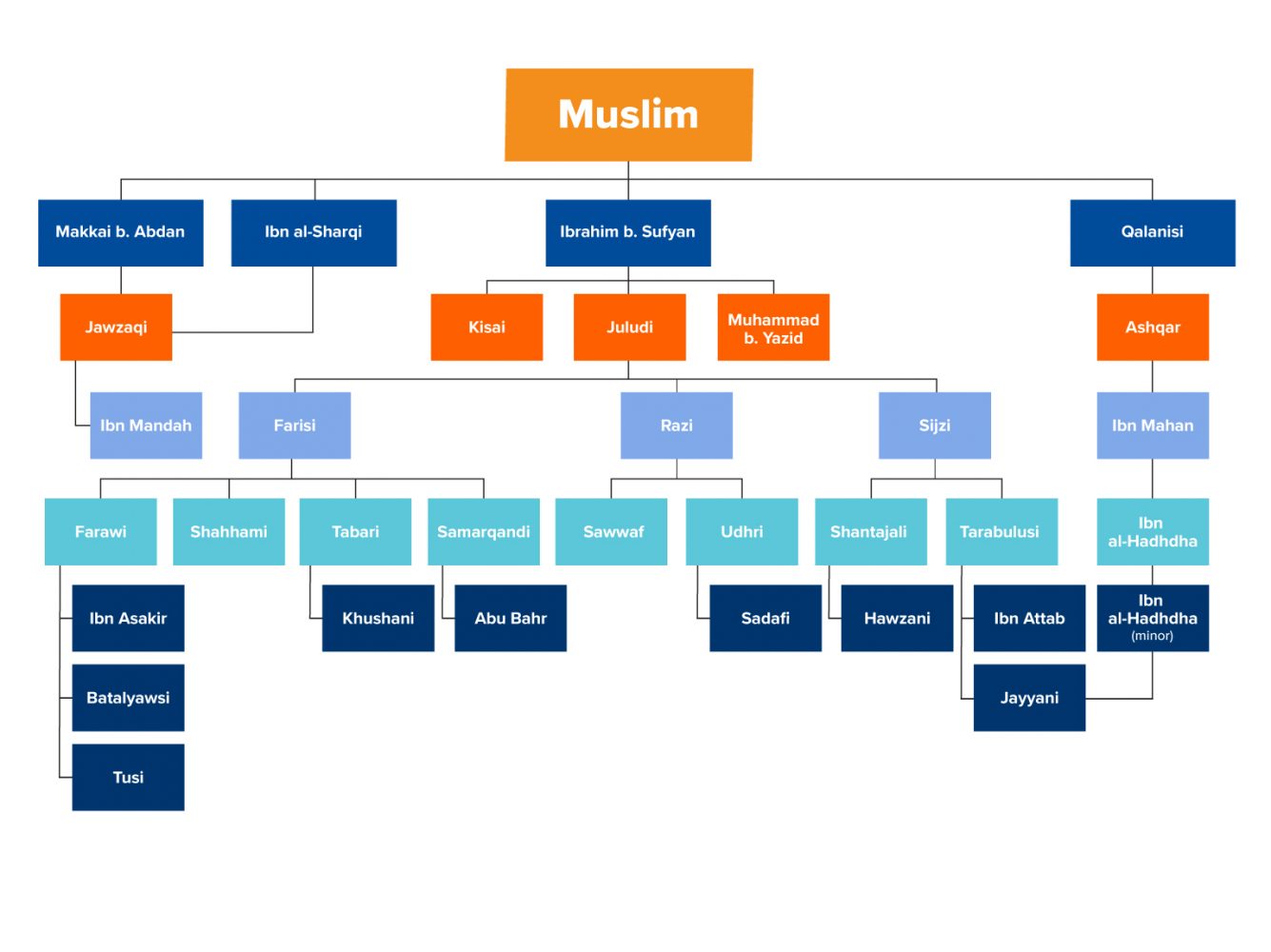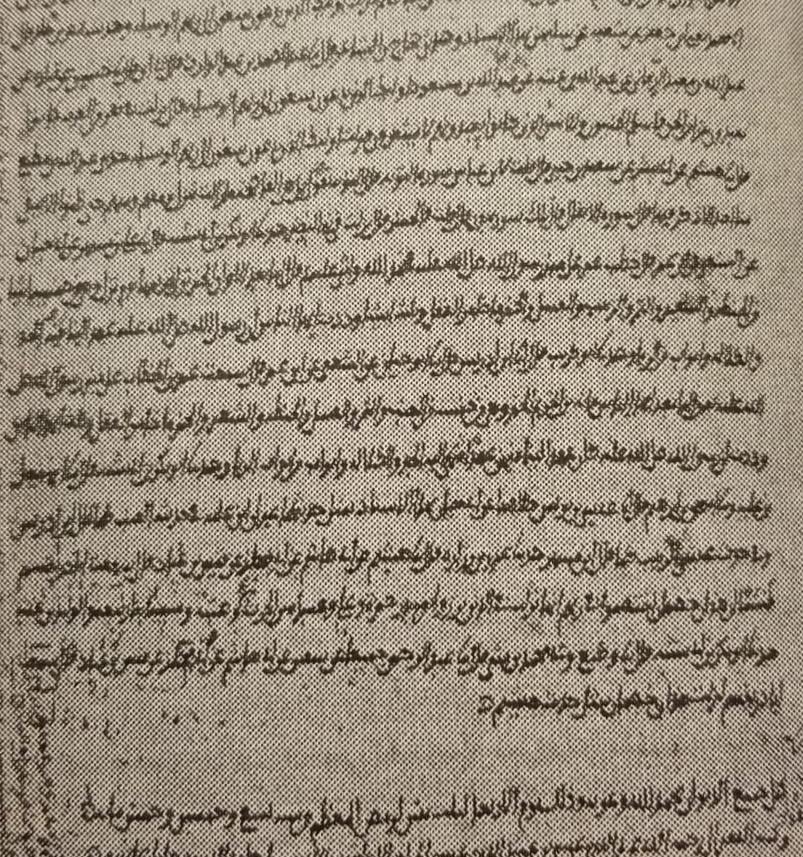
Tracing Transmissions: The Accuracy of Sahih Muslim
For more on this topic, see Hadith Series
Introduction
Transmitters

Manuscripts
Finalized Text or Fluid Text?
Abū Bakr ibn Abī Shaybah narrated to us, saying: Wakīʿ narrated to us, saying: al-Aʿmash narrated to us, from al-Maʿrūr ibn Suwayd, from Abū Dharr, who said: the Messenger of Allāh (peace and blessing be upon him) said: Allāh said, “Whoever carries out a good deed will receive tenfold or more…” Ibrāhīm said: al-Ḥasan ibn Bishr narrated to us, saying: Wakīʿ narrated to us (continuing with Muslim’s chain) this ḥadīth.[54]
Conclusion
Appendix



Notes
[1] The entire title of Ṣaḥīḥ Muslim is al-Musnad al-Ṣaḥīḥ al-Mukhtaṣar min al-Sunan bi Naql al-ʿAdl ʿan al-ʿAdl ʿan Rasūl Allāh ṣallallāhu ʿalayhi wasallam. On the title of Ṣaḥīḥ Muslim, see Abū Ghuddah, Taḥqīq Ismay al-Ṣaḥīḥayn wa Ism Jāmiʿ al-Tirmidhī, p. 33.
[2] Nizār Rayyān, Ṣaḥīḥ al-Imām Muslim: Asānīduhu wa Nusakhuhu wa Makhṭūṭatuhu wa Ṭabaʿātuhu, Majallat al-Jāmiʿah al-Islāmiyyah, p. 323.
[3] Al-Sakhāwī, al-Jawāhir wa al-Durar, vol.1, p. 162. On the phenomenon of speed-reading Ḥadīth literature, see Garrett Davidson, Carrying on the Tradition: An Intellectual and Social History of Post-Canonical Hadith Transmission, pp. 107-112.
[4] Al-Dhahabī, Siyar Aʿlām al-Nubalāʾ, vol. 19, p. 625.
[5] Mashhūr Ḥasan, al-Imām Muslim ibn al-Ḥajjāj, pp. 251-257.
[6] Zubayr Siddiqi, Ḥadīth Literature: Its Origins, Development, and Special Features, p. 59.
[7] Abū Ghuddah, “Appendix,” in al-Mūqiẓah, pp. 137-140; ʿAbd al-Raḥmān Ṭawālbah, al-Imām Muslim wa Manhajuhū fī Ṣaḥīḥīh, pp. 104-105.
[8] For a list of Muslim’s students, see al-Dhahabī, Siyar Aʿlām al-Nubalāʾ, vol. 12, p. 562.
[9] Ibn al-Ṣalāḥ, Ṣiyānat Ṣaḥīḥ Muslim, p. 103; al-Nawawī, al-Minhāj, vol. 1, p. 11; al-Sakhāwī, Ghunyat al-Muḥtāj, p. 40.
[10] Al-Dhahabī, Siyar Aʿlām al-Nubalāʾ, vol. 14, pp. 311-312.
[11] Ibrāhīm ibn Sufyān heard the Ṣaḥīḥ from Muslim in 257 AH. There are three sections where he says, “from Muslim” instead of “Muslim narrated to us,” which indicates that he may not have heard several ḥadīths directly from Muslim. Ibn al-Ṣalāḥ explains that Ibrāhīm received general authorization (ijazah) for these ḥadīths from Muslim or narrated them from him via wijādah. Ḥusayn Shawwāṭ states that this phraseology is based on the audition of 257 AH. Since Ibrāhīm stayed in Muslim’s company for several more years, it is not unlikely that he heard these ḥadīths from Muslim later. ʿAbd Allāh Damfū adds that even if we accept that Ibrāhīm only received general authorization for these ḥadīths, there is continuous audition for them in al-Qalānisī’s recension. See Ṣiyānat Ṣaḥīḥ Muslim, pp. 103-104; Ibn Ḥajar, al-Muʿjam al-Mufahras, pp. 27-28; ʿAbd Allāh Damfū, Ibrāhīm ibn Muḥammad ibn Sufyān: Riwāyātuhu wa Ziyādātuhu wa Taʾlīqātuhū ʿalā Ṣaḥīḥ Muslim, Majallat al-Jāmiʿah al-Islāmiyyah, vol. 111 (2001), pp. 178-182.
[12] Ibn al-Ṣalāḥ, Ṣiyānat Ṣaḥīḥ Muslim, p. 104.
[13] Al-Samʿānī, al-Ansāb, vol. 11, p. 102.
[14] Ibid., vol. 12, pp. 75-76.
[15] Ibn al-Ṣalāḥ, Ṣiyānat Ṣaḥīḥ Muslim, pp. 103, 109.
[16] Al-Jayyānī, Taqyīd al-Muhmal, vol. 1, p. 66.
[17] Muḥammad al-Shādhilī, “Introduction,” in al-Muʿlim bi Fawāʾid Muslim, p. 181.
[18] See, for instance, al-Jayyānī, Taqyīd al-Muhmal, vol. 3, p. 768; al-Māzarī, al-Muʿlim, vol. 1, pp. 396, 397, 418; ʿIyāḍ, Ikmāl al-Muʿlim, vol. 1, pp. 238, 329, 489, 585.
[19] See, for instance, pp. 10 (qāl Muslim: Jarīr kunyatuhu…), 11 (the word khamsah). A link to a digital copy of this manuscript is provided below.
[20] Al-Sakhāwī, Ghunyat al-Muḥtāj, p. 40.
[21] Ibid.
[22] Al-Khalīlī, al-Irshād, vol. 3, p. 826. In a treatise on this topic, al-Ḍiyāʾ al-Maqdisī (d. 643 AH) lists ten people who transmitted the Ṣaḥīḥ from Imām Muslim. See ʿĀdīl al-Sabīʿī, Riwāyāt Ṣaḥīḥ Muslim, Majallat al-Jāmiʿah al-Islāmiyyah li al-ʿUlūm al-Sharīʿah, no. 185, pp. 133-134.
[23] Mashhūr Ḥasan, al-Imām Muslim ibn al-Ḥajjāj, p. 167.
[24] For more information on the names of the transmitters found in the appended chart, see the introduction to Ṣaḥīḥ Muslim, ed. Dār al-Taʾṣīl, vol. 1, pp. 118-177. Some transmissions were omitted from the chart for brevity, such as the route of Hātim al-Ṭarābulusī from Abū Muḥammad al-Ṣiqillī from al-Kisāʿī from Ibrāhīm ibn Sufyān. See Ibn Khayr, al-Fihrist, p. 86; cf. al-Mizzī, Tuḥfat al-Ashrāf, no. 8206.
[25] The al-Fahras al-Shāmil catalog details the whereabouts of 532 manuscripts of Ṣaḥīḥ Muslim. See al-Fahras al-Shāmil li al-Turāth al-ʿArabī al-Islāmī al-Makhṭūṭ, pp. 574-590.
[26] Brockelmann, Geschichte der Arabischen Litteratur (Arabic trans.), vol. 3, p. 180.
[27] See the Khuda Bakhsh Oriental Library catalog, vol. 5, pp. 79-80.
[28] Ṣaḥīḥ Muslim, ed. Dār al-Taʾṣīl, vol. 1, p. 187 (note 1).
[29] See, for instance, al-Māzarī, al-Muʿlim bi Fawāʾid Muslim, vol. 1, p. 451.
[30] Al-Jayyānī, Taqyīd al-Muhmal, vol. 1, p. 65; cf. Ṣaḥīḥ Muslim, ed. Dār al-Taʾṣīl, vol. 1, pp. 178-180, 182.
[31] Ṣaḥīḥ Muslim, ed. Dār al-Taʾṣīl, vol. 1, p. 225 ff.
[32] https://archive.org/download/m-0002/06870-0311007.zip (last accessed November 30, 2018).
[33] Abū Ghuddah, Taḥqīq Ismay al-Ṣaḥīḥayn wa Ism Jāmiʿ al-Tirmidhī, pp. 43-45.
[34] Al-Kattānī, Fahras al-Fahāris, vol. 1, p. 385. Shaykh ʿAbd al-Fattāḥ Abū Ghaddah writes that due to its thorough cross-analysis, marginal notes, and auditions, Ibn Khayr’s manuscript is, in fact, the most valuable extant manuscript in the world, not only in North Africa as Shaykh al-Kattānī mentioned. See Abū Ghuddah, Taḥqīq Ismay al-Ṣaḥīḥayn, p. 45.
[35] http://wadod.com/bookshelf/book/734 (last accessed November 30, 2018).
[36] See the closing remarks of their edition on vol. 2, p. 744; cf. Brockelmann, Geschichte der Arabischen Litteratur (Arabic trans.), vol. 3, p. 180.
[37] Nūr al-Ḥasan Kāndhlawī, Ḥazrat Mawlānā Aḥmad ʿAlī Sahāranpūrī kī Khidmāt-e Ḥadīth, in Hindustān awr ʿIlm-e Ḥadīth, pp. 286-287.
[38] The text was edited by Aḥmad Rifʿat and Muḥammad ʿIzzat several times using reliable manuscripts. Unfortunately, a description of these manuscripts was not provided. It was then revised and annotated by Muḥammad Shukrī al-Anqarawī. See Muṣaddiq al-Dūrī, Riwāyat Ṣaḥīḥ Muslim min Ṭarīq Ibn Māhān Muqāranah bi Riwāyat Ibn Sufyan, pp. 45-46.
[39] Zuhayr Nāṣir, “Preface,” in Ṣaḥīḥ al-Imām Muslim, vol. 1, p. 30.
[40] Ṣaḥīḥ Muslim, ed. Dār al-Taʾṣīl, vol. 1, pp. 225 ff., 246, 273. For the purposes of text-verification, Dār al-Taʾṣīl also consulted other resources like commentaries and supplementary works on the Ṣaḥīḥ.
[41] A digital copy is available online: https://ia800204.us.archive.org/29/items/m-0001/3736---01.pdf (last accessed December 7, 2018). The al-Fahras al-Shāmil catalog details a manuscript of Ṣaḥīḥ Muslim that is dated to 368 AH, a century after Muslim’s demise, located in the Alexandria Municipal Library in Egypt. See al-Fahras al-Shāmil li al-Turāth al-ʿArabī al-Islāmī al-Makhṭūṭ, p. 574. However, the information provided in the catalog is incorrect. The manuscript held in the Alexandria Library (item no. 836B) is correctly dated to 368 AH and is even titled “al-Juzʾ al-Thālith ʿAshar min Ṣaḥīḥ al-Imām Muslim,” but unfortunately it is not a manuscript of Ṣaḥīḥ Muslim. Rather, it is a partial manuscript of Qāḍī Isḥāq al-Bustī’s (d. 307 AH) Qurāʾnic exegesis. It is possible that the librarian who labeled this manuscript confused the two books due to similarities in their structure: al-Bustī’s work is a transmission-based exegesis (maʾthūr) filled with chains of transmission that resemble the structure of Muslim’s Ṣaḥīḥ. I would like to thank Shaykh Aḥmad ʿĀshūr from Madinah for sharing his insights on this manuscript. The manuscript can be obtained here: https://ia600705.us.archive.org/15/items/m0368/tafsir_busti.pdf (last accessed December 7, 2018).
[42] Norman Calder, Studies in Early Muslim Jurisprudence, p. 194.
[43] Muṣaddiq al-Dūrī, Riwāyat Ṣaḥīḥ Muslim min Ṭarīq Ibn Māhān Muqāranah bi Riwāyat Ibn Sufyan, p. 79.
[44] Abū ʿAlī al-Jayyānī writes that Ibn Māhān transmits the entire Ṣaḥīḥ from al-Ashqar via al-Qalānisī apart from the last three parts which he transmits via al-Julūdī from Ibrāhīm. See al-Jayyānī, Taqyīd al-Muhmal, vol. 1, p. 66; Ibn al-Ṣalāḥ, Ṣiyānat Ṣaḥīḥ Muslim, p. 109; al-Dhahabī, Siyar Aʿlām al-Nubalāʾ, vol. 16, p. 536.
[45] From 117 cases, there are only 36 instances in Ibn Māhān’s recension and 4 instances in the recension of Ibrāhīm Sufyān that are mistakes or scribal errors. See al-Dūrī, Riwāyat Ṣaḥīḥ Muslim, p. 390.
[46] Muslim, al-Musnad al-Ṣaḥīḥ, no. 3023.
[47] Al-Dūrī, Riwāyat Ṣaḥīḥ Muslim, p. 388.
[48] Ṣaḥīḥ Muslim, ed. Dār al-Taʾṣīl, vol. 1, pp. 99-102, 291.
[49] Abū Zurʿah al-Rāzī, al-Ḍuʿafāʾ, vol. 2, pp. 674-677. On Abū Zurʿah’s comments on Ṣaḥīḥ Muslim, see Mashhūr Ḥasan, al-Imām Muslim ibn al-Ḥajjāj, pp. 101-02; ʿAwwāmah, Annotations on Tadrīb al-Rāwī, vol. 2, pp. 326-328.
[50] Abū Zurʿah al-Rāzī, al-Ḍuʿafāʾ, vol. 2, pp. 674-675.
[51] Al-Suyūṭī, Tadrīb al-Rāwī. vol. 2, pp. 421-427.
[52] Jonathan Brown, The Canonization of al-Bukhārī and Muslim, p. 386.
[53] Damfū, Ibrāhīm ibn Muḥammad ibn Sufyān: Riwāyātuhu wa Ziyādātuhu wa Taʾlīqātuhū ʿalā Ṣaḥīḥ Muslim, pp. 171, 192 ff. Ibrahīm makes six comments throughout the Ṣaḥīḥ. See ibid., pp. 215-228.
[54] Muslim, al-Musnad al-Ṣaḥīḥ, no. 2687.
[55] Tobias Andersson, Early Sunnī Historiography: A Study of the Tārīkh of Khalīfa b. Khayyāṭ, pp. 21-28.
[56] Damfū, Ibrāhīm ibn Muḥammad ibn Sufyān, pp. 186-190; Mutawallī, Ziyādāt al-Imām Muḥammad ibn Yūsuf ibn Maṭar al-Firabrī ʿalā Ṣaḥīḥ al-Bukhārī, pp. 593-598.
[57] There are nearly 20 exclusive mustakhraj works on Ṣaḥīḥ Muslim and at least 50 commentaries that were written between 500-1000 AH, not to mention a long list of other material. Furthermore, countless books were written on the two Ṣaḥīḥs collectively. See Mashhūr Ḥasan, al-Imām Muslim ibn al-Ḥajjāj, pp. 221-224, 251-257.
